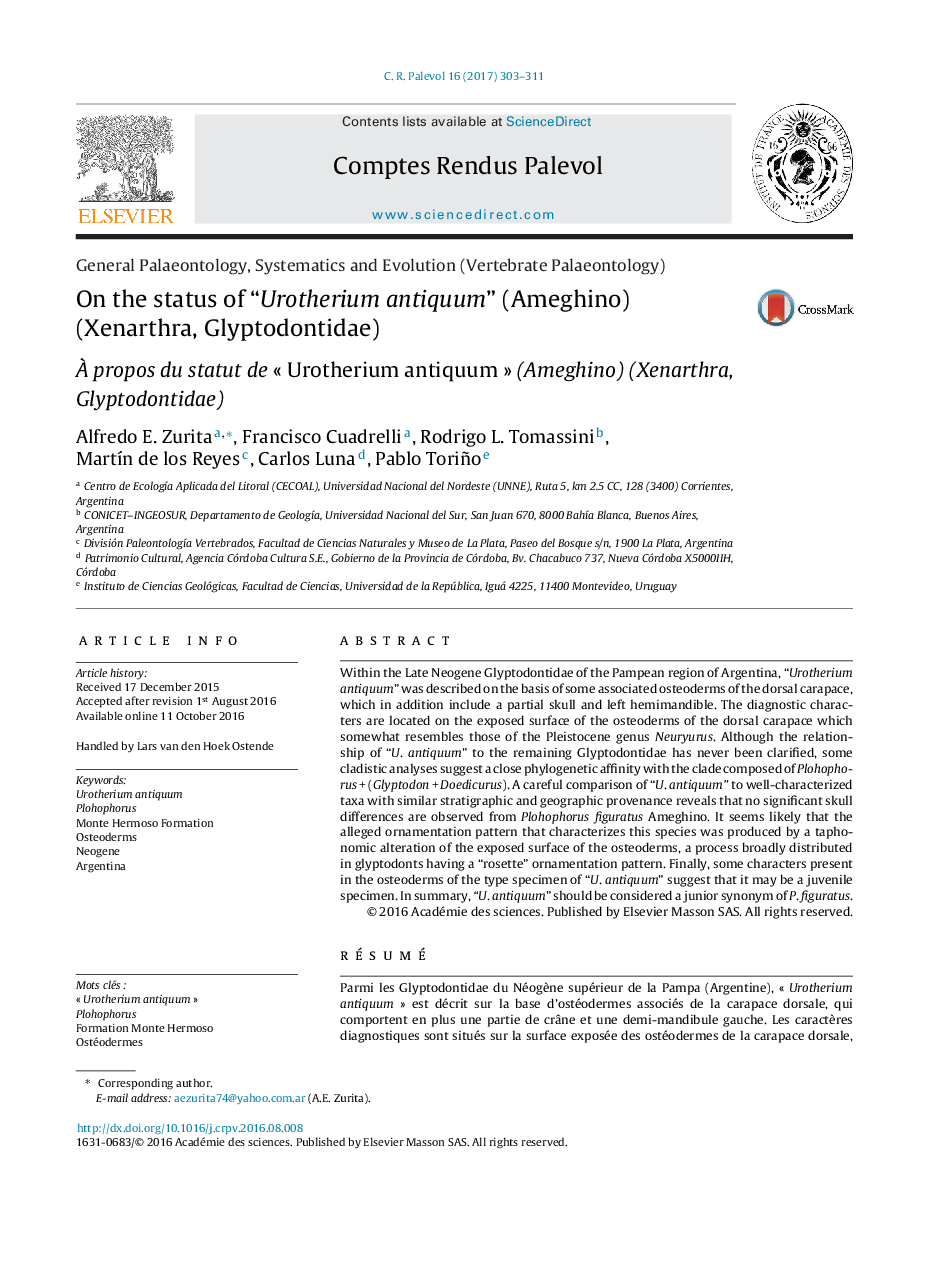| کد مقاله | کد نشریه | سال انتشار | مقاله انگلیسی | نسخه تمام متن |
|---|---|---|---|---|
| 5787871 | 1414203 | 2017 | 9 صفحه PDF | دانلود رایگان |

Within the Late Neogene Glyptodontidae of the Pampean region of Argentina, “Urotherium antiquum” was described on the basis of some associated osteoderms of the dorsal carapace, which in addition include a partial skull and left hemimandible. The diagnostic characters are located on the exposed surface of the osteoderms of the dorsal carapace which somewhat resembles those of the Pleistocene genus Neuryurus. Although the relationship of “U. antiquum” to the remaining Glyptodontidae has never been clarified, some cladistic analyses suggest a close phylogenetic affinity with the clade composed of Plohophorus + (Glyptodon + Doedicurus). A careful comparison of “U. antiquum” to well-characterized taxa with similar stratigraphic and geographic provenance reveals that no significant skull differences are observed from Plohophorus figuratus Ameghino. It seems likely that the alleged ornamentation pattern that characterizes this species was produced by a taphonomic alteration of the exposed surface of the osteoderms, a process broadly distributed in glyptodonts having a “rosette” ornamentation pattern. Finally, some characters present in the osteoderms of the type specimen of “U. antiquum” suggest that it may be a juvenile specimen. In summary, “U. antiquum” should be considered a junior synonym of P. figuratus.
RésuméParmi les Glyptodontidae du Néogène supérieur de la Pampa (Argentine), « Urotherium antiquum » est décrit sur la base d'ostéodermes associés de la carapace dorsale, qui comportent en plus une partie de crâne et une demi-mandibule gauche. Les caractères diagnostiques sont situés sur la surface exposée des ostéodermes de la carapace dorsale, qui ressemblent un peu à ceux du genre pléistocène Neuryurus. Quoique la relation de « U. antiquum » avec les Glyptodontidae restants n'ait jamais été précisée, quelques analyses cladistiques suggèrent une proche affinité phylogénétique avec le clade composé de Plohophorus + (Glyptodon + Doedicurus). Une comparaison soigneuse de « U. antiquum » avec des taxons bien caractérisés de provenances stratigraphiques et géographiques similaires révèle qu'aucune différence significative au niveau du crâne n'est observée chez Plohophorus figuratus Ameghino. Il semble probable que le motif d'ornementation supposé qui caractérise cette espèce a été produit par une altération taphonomique de la surface exposée des ostéodermes, un processus largement répandu chez les glyptodontes présentant un motif d'ornementation « en rosette ». Finalement, quelques caractères présents chez les ostéodermes du spécimen type d'« U. antiquum » suggèrent qu'il puisse s'agir d'un juvénile. En résumé, « U. antiquum » devrait être considéré comme un synonyme junior de P. figuratus.
Journal: Comptes Rendus Palevol - Volume 16, Issue 3, AprilâMay 2017, Pages 303-311